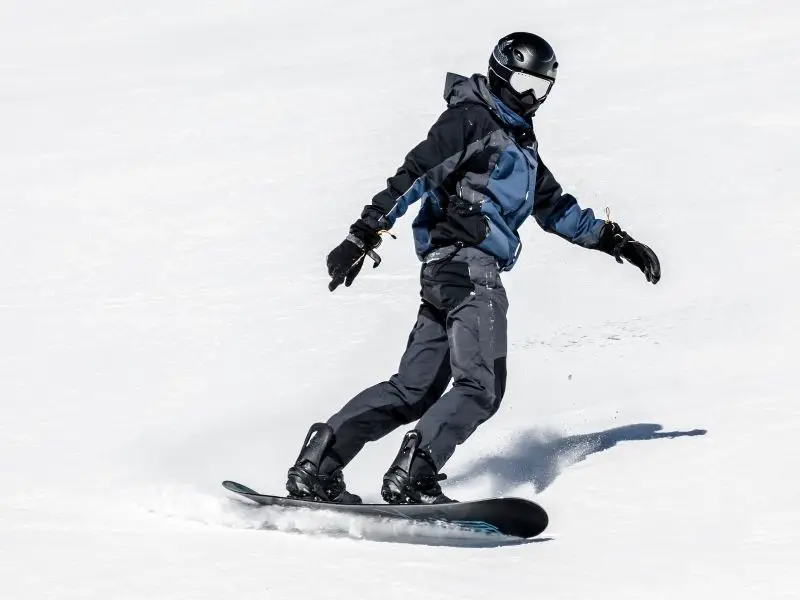You have an invitation to go snowboarding this winter, and you’re excited about the offer, but you realize there’s only one pair of boots in your house: hiking boots.
Likewise, some who regularly go on hiking trips yet sometimes want to board when the winter comes might utilize their hiking boots with the snowboard. So the question is if you can wear hiking boots for snowboarding.
Frankly, hiking boots cannot deliver adequate toe and heel control like a pair of snowboard boots. Snowboard boots are designed to deliver stability and support when riding. They reliably and securely fit in the bindings that are only utilized with snowboard footwear.
With that being said, there are some types of hiking boots made for snow and cold seasons. Hiking boots for snow come with an insulated, waterproof upper and non-slip outsole, making it feel close to snowboard models. These models can be used for snowboarding.
Contents
Can You Use Hiking Boots for Snowboarding?
As mentioned above, hiking boots cannot deliver enough toe and heel support for snowboarding like snowboard boots.
However, you can use hiking boots for snowboarding, because they can still provide decent support and protection for ankles, heels and toes, but you won’t get the best experience.
They are typically more supportive and beefier if they have high insulation (around 200g), waterproof or snowproof upper, and non-slip outsoles.
And the part that I think you’re most looking forward to is that they can be adjusted to fit the snowboard bindings. The connection between hiking boots and bindings is very important. They give you balance and stability on the board.
There are various hiking boots designed with these features to help them work for snowboarding in today’s market. They come with a rubber outsole with lug patterns, delivering improved grip and great traction and shedding snow more easily.

Furthermore, to help your mountaineering boots protect your feet in cold conditions when snowboarding, it is best to consider using footwear with the following accessories.
- Gaiters: They act as a barrier or cover for your feet, helping thwart the cold from getting into your feet. You can wear them above the hiking boots for an improved insulating barrier.
- Thermal insoles: They add heat and comfort in snowy weather, insulating your feet from the extreme cold on the surface.
- Winter or thermal socks: Made of fleece, wool, and shearing to trap the heat, winter socks will provide optimal insulation even when they are wet.
Last update on 2023-11-10 / Affiliate links / Images from Amazon Product Advertising API
So it is okay if you use your hiking boots for snowboarding as long as they come with good support (heel, ankle, toe), waterproof upper, non-slip outsoles, and high insulation.
However, don’t expect that hiking boots can work well as snowboard boots when used for snowboarding.
In case you want to buy hiking boots for snowboarding, let’s follow us to the next section for a helpful buying guide.
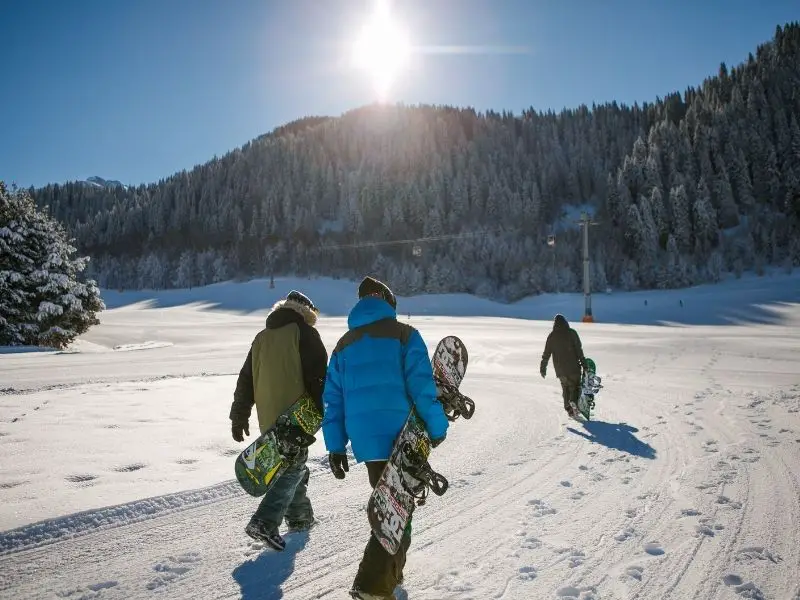
How To Choose Hiking Boots For Snowboarding?
What to look for in hiking boots for snowboarding?
Below is the answer!
Fit
The most important thing you need to pay attention to when choosing hiking boots for snowboarding is the fit of the boots. They need to fit perfectly.
Snowboarding boots are always designed to easily fit your feet perfectly and amazingly when wearing, thereby creating a high level of stability for riding.
Hiking boots definitely need to have that fit if you want to use them for snowboarding. Choose hiking boots that you really feel comfortable wearing, not loose and not tight.
High-cut hiking boots
It is best to choose high-cut hiking boots for snowboarding. These boots are the best option in terms of sturdiness. They come with a cuff to rise several inches above your ankle bone. The lacing system can stabilize its collar to be snug to your legs.
They are typically made of rubber and a mixture of leather, which are highly waterproof to keep the feet dry in snowy conditions. Thus, high-cut hiking boots are the best choice for snowboarding.
Almost all hiking boots for snow are high-cut models. They come with several characteristics different from conventional hiking boots. For instance, they provide high insulation and good outsoles with deep lugs to provide great traction.

Comfort
Another critical factor to consider when choosing hiking boots for snowboarding is comfort. Why should your hiking boots be comfortable?
We have heard many complain about their foot soreness due to wearing uncomfortable footwear. So this is a must to make snowboarding newbies want to ride again. Learning how to snowboard is itself difficult enough without handling foot soreness.
Hiking boots need to be breathable to provide high comfort. To do that, they should come with suitable materials like Gore-Tex membrane and nylon. Besides, it is best to feature cushion insoles and midsoles to reduce soreness, foot fatigue and blisters after activities.
On top of that, the hiking boots should fit your feet properly as snowboarding requires more flexible and tricky movements than conventional running or walking.
Plus, they need to snugly fit around your ankles and heels while giving a right roomy toe box for your toes to feel the board.
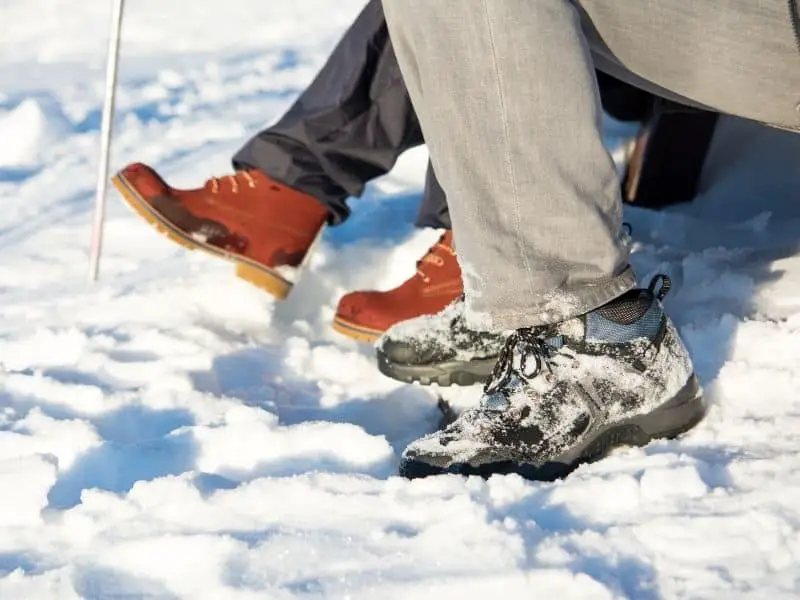
Protection
If you are going snowboarding, it is imperative to choose hiking boots that provide comprehensive protection when trudging on snowy terrain.
Below are several variables to help protect the feet from the environmental elements.
- Non-slipping and waterproofness:
It is best to choose hiking boots with rubber outsoles and leather uppers. While non-slip outsoles will help the hikers avoid falling and slipping on icy ground, the leather upper can help deter water and wet snow from reaching your feet.
Thus, your feet will be dry during snowboarding sessions. Hiking boots for snow feature a waterproof and breathable lining between the materials of the uppers to keep the feet dry when snowboarding.
- Right reinforced toe cap:
Hiking boots for snow – a good type of hiking boots for snowboarding – come with a toe cap made of composite/plastic and steel to protect toes from sharp objects and rocks.

Durability
As your hiking boots will expose to harsh snowy conditions when riding, they need to be durable, which is attributable to the materials of hiking boot uppers and outsoles.
Hiking Boot Uppers
- Full-grain leather: This material provides optimal abrasion, durability, and water resistance. It is widely available in hiking boots designed for extended journeys, rugged terrain, and heavy loads.
- Suede: it is regularly combined with nylon mesh or nylon to deliver lightweight hiking boots to provide optimal breathability. This material delivers lower water and abrasion resistance.
- Nylon fabrics: they are commonly used in modern hiking boots. They are more lightweight than leather models. That said, the uppers made on this material seem to wear sooner because of more stitching on the hiking boots’ exterior.
So if you need highly durable hiking boots when riding in snow, we highly recommend you choose models with uppers made of 100% leather.
Meanwhile, if you prefer a flexible and lightweight model for free movement, it is better to go for suede or nylon fabrics (Denier Nylon, Cordura…) hiking boots.
Nevertheless, keep in mind that the lightweight design will lead to a drop in abrasion and water resistance.
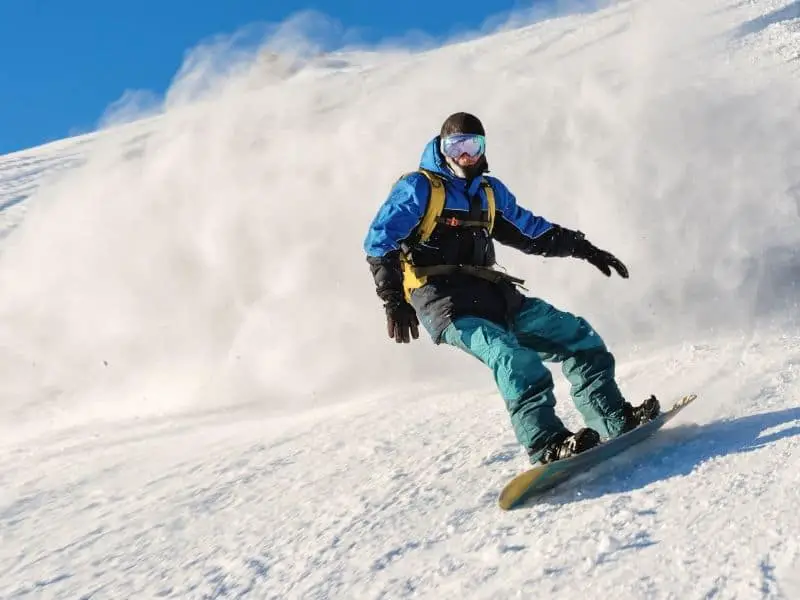
Hiking Boot Outsoles
Hiking boots come with rubber outsoles. You might not know this, but hard outsoles can boost durability yet feel slick if you go on snowboarding.
- Lugs: they are the bumps to give traction on the outsoles. Thicker and deeper lugs are chosen for hiking boots for snowboarding to enhance grip. Plus, a widely spaced lug pattern provides great traction.
- Heel brake: The heel zone separates the heel and forefoot, helping lower the chance of slipping and sliding in steep descents.
Rubber outsoles will help your hiking boots be durable enough to ride in the snow.
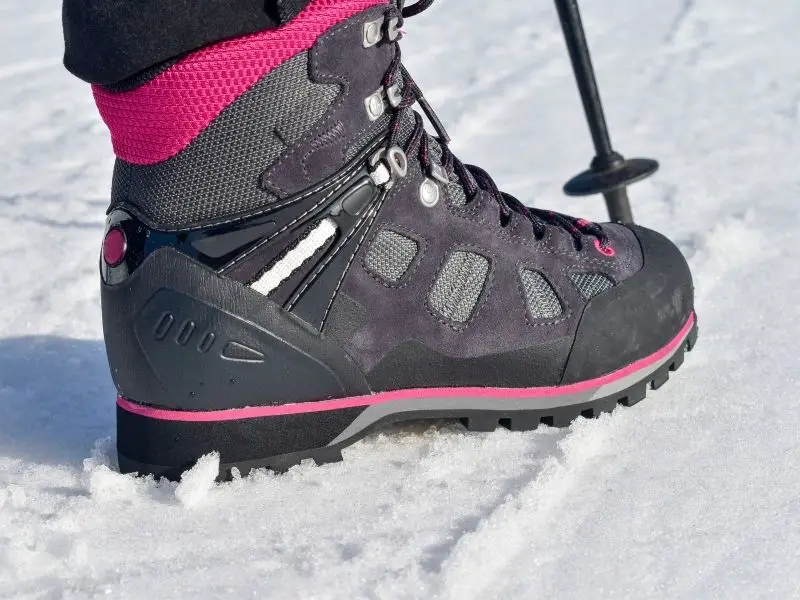
Top 3 Hiking Boots Good for Snowboarding
We will continue with in-depth reviews of the top 3 hiking boots for snowboarding.
1. Manfen Lightweight Hiking Boots

We prize the Manfen Lightweight Hiking Boots as the top hiking boots for snowboarding. This product outweighs other hiking boots for its waterproof mesh upper and hydroshield membrane to deal with wet, snowy conditions.
Plus, the boots feature an ergonomic chassis covered with foam cushioning for high comfort to connect to the soles for your heel stability directly. With the 200g insulation, your feet can be warm and dry in the harsh snow.
As the Manfen Lightweight hiking boots are completely waterproof, you can be confident to wear them for mud and snowy terrain. Notably, the boots boast a molded heel pad for excellent heel and arch protection.
We also like these boots for their supportive hook to help you deal with deep snow.
Still, these hiking boots have a flat and flimsy footbed, causing discomfort when wearing.
- ADVANCED TECHNOLOGY---Integrated inserted EVA midsole,waterproof hiking boot features our...
- MAY BE SMALLER THAN NORMAL SIZE, RECOMMEND ORDERING A FULL SIZE UP FROM YOUR NORMAL SIZE.
- ANTI-SKID PERFORMANCE---Rubber toe cap protection & rubber outsole for optimal trail grip to rotect...
Last update on 2023-11-11 / Affiliate links / Images from Amazon Product Advertising API
Pros:
- Waterproof mesh upper and hydroshield membrane for wet and snowy conditions
- Ergonomic chassis to provide high comfort
- 200g insulation for dry and warm feet
- Waterproof design to protect against snow
- Molded heel pad for excellent heel and ankle protection
Cons:
- Uncomfortable flimsy and flat footbed
2. XPETI Thermator Waterproof Hiking Boots

The next position belongs to the XPETI Thermator Waterproof Hiking Boots. This suggestion wins our hearts thanks to advanced technology to offer comprehensive protection for the feet when snowboarding.
There is also a waterproof mesh upper paired with an X-Dry membrane to retain the dryness and warmth of your feet while riding in snow conditions.
On top of that, the boots feature a rubber toe cap to deliver high protection for your toes. Hence, you are likely to tackle snowy terrain with confidence.
The XPETI hiking boots deliver good traction to help you ride in the snow thanks to an exclusive outsole design. With the high Thinsulate insulation of 200g for -13 degrees Fahrenheit, these boots can significantly keep your feet warm.
Nevertheless, these hiking boots are a bit tight at first use. In other words, it will take you a certain amount of time to put on them.
- WATERPROOF: The boots are made from waterproof mesh upper and X-DRY Membrane...
- ADVANCED TECHNOLOGY: 200 Grams Thinsulate Insulation for -13°F. Integrated inserted EVA Midsole,...
- TRACTION: Super aggressive X-grip rubber outsole with 7mm multi-directional lugs provides...
Last update on 2023-11-11 / Affiliate links / Images from Amazon Product Advertising API
Pros:
- Waterproof mesh upper for dry and warm feet
- Rubber toe cap for toe high protection
- Deliver good traction to ride in the snow thanks to ergonomic outsole design
- High insulation of 200g to keep the feet warm when riding in snow
Con:
- It may require a proper break-in period.
3. Wantdo Waterproof Hiking Boots

Our last pick is the Wantdo Waterproof Hiking Boots. What sets it apart from other products is a Vibram ICETREK rubber outsole with high stability, slip resistance, and durability to bring confidence to your feet even at the temperature of -9 degrees Fahrenheit.
To provide superb cushioning and comfort when snowboarding in the long run, these hiking boots feature an EVA thick and stable midsole. We are also impressed with its advanced seam sealing technology, keeping your feet dry and warm when riding through snow.
Notably, the Wantdo Waterproof Hiking Boots are very warm due to the high insulation. On top of that, the footwear can comprehensively keep the water or wet snow out, not to mention, handle traveling in 5-inch-deep snow or water easily.
Plus, you will like the footwear’s 6mm-deep lugs that can deliver great traction to help you deal with tricky and slippery terrain when snowboarding.
On the downside, this suggestion does not provide long-lasting waterproof capability if you ride in snow in constant moisture because they come with textile fabric and mesh upper, not leather.
- Waterproof--The men's hiking boots features durable textile and TPU upper,could effectively prevent...
- Slip-resistant--This non slip tactical boots with 6mm deep (Vibram) outsole provides excellent...
- Durability--The waterproof work boots for men has rugged Vibram rubber outsole, which could provide...
Last update on 2023-11-11 / Affiliate links / Images from Amazon Product Advertising API
Pros:
- Vibram ICETREK rubber outsole with high stability, slip resistance, and durability
- EVA thick and stable midsole for high comfort
- Advanced seam sealing technology to keep feet warm and dry
- Able to handle 5-inch-deep snow easily
- 6mm-deep lugs for great traction to handle slippery terrain
Con:
- Not ideal for use in a constant moisture
Wrapping Up
In short, if hiking books work for snowboarding relies on many factors like materials, comfort, and protection. It is best to choose hiking boots for snow as they regularly come with high insulation, waterproof uppers, and non-slip outsoles.
If you are still confused about choosing the right hiking boots for snowboarding, we highly recommend you go through the second section again.
Do not forget to share your story with us in the comment section below. Thank you for reading!

